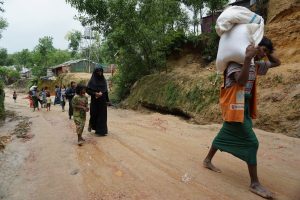The United Nations and human rights groups have condemned Bangladesh’s relocation of Rohingya refugees to an uninhabited and cyclone-swept island in the Bay of Bengal, claiming that many have been coerced and pressured into the move.
On December 4, Bangladeshi officials began ferrying the first group of 1,642 refugees to Bhasan Char, an island lying some 34 kilometers from the mainland. In a report published a day earlier, the Reuters news agency quoted refugees and humanitarian workers as saying that some of the people being shipped to the island have been forced or tricked into doing so, despite government assertions that the relocations were voluntary.
Reuters reporters Ruma Paul and Poppy McPherson spoke to two Rohingya civilians who said their names appeared on lists compiled by government-appointed local leaders without their consent. Meanwhile, aid workers said officials “used threats and offers of cash and other enticements” to pressure people into going to what many refugees and human rights groups have likened to an “island detention center.”
The New York-based rights organization Human Rights Watch (HRW) claims to have spoken with 12 families who said their names were on the list, but that they had not willingly volunteered to relocate. Some refugees on the list have gone into hiding to avoid the transports, while Reuters reported that a heavy security presence was deployed in the refugee camps.
“They have taken us here forcefully,” a 31-year-old Rohingya man told Reuters by phone on December 3 as he boarded a bus to the port city of Chittagong, where seven naval vessels began transporting people to Bhasan Char the following day. “Three days ago, when I heard that my family is on the list, I ran away from the block, but yesterday I was caught and taken here,” he said.
The people being transferred represent just a tiny portion of the estimated one million Rohingya Muslims currently living in the brimming refugee camps of Cox’s Bazar, close to the border with Myanmar. The majority arrived in Bangladesh after Myanmar military offensives in August 2017, which forced more than 700,000 people to flee their homes in Rakhine State. The crisis has lumped Bangladesh with a massive humanitarian emergency, one with no real end in sight.
The island plan is Bangladesh’s way of trying to reduce the pressure inside the refugee camps and find a lasting solution to the crisis, given the many obstacles facing refugees’ return to Myanmar. Over the past few years, the Bangladeshi navy has built flood protection embankments, houses, hospitals, and mosques on Bhasan Char, which means “floating island” in Bengali. The government insists that the island is well-equipped and the relocations are voluntary. “They are going there happily. No one is forced,” one Bangladeshi official told Reuters.
But the island relocation scheme has been stridently opposed by the United Nations and international aid agencies since Bangladesh first came up with the idea in 2015. These groups are concerned that the island, which rose from the waves two decades ago and has never been inhabited, is remote, flood prone, and dangerously vulnerable to the cyclones that frequently scythe through the Bay of Bengal. Ismail Wolff, regional director of the nonprofit rights organization Fortify Rights, this week likened Bhasan Char to “an island detention center.”
In a statement, Saad Hammadi of the rights group Amnesty International said that any relocation scheme could only take place with the “full and meaningful participation” of those involved. “No relocation plan, either to Bhasan Char or to another location, can be undertaken without the full and informed consent of the individuals involved.” Refugees International said the move was “nothing short of a dangerous mass detention of the Rohingya people in violation of international human rights obligations.”
The drastic island relocation plan and the backlash it has engendered testify to the many obstacles facing a lasting resolution to the humanitarian emergency in the Myanmar-Bangladesh border region.
While the U.N. High Commissioner for Refugees has expressed support for “the voluntary and sustainable repatriation of Rohingya refugees in safety and in dignity to their places of origin or choice,” this looks increasingly unlikely as time goes by. Rohingya refugees face the hostility of the authorities and much of the population in Rakhine State, who refuse to recognize them as citizens of Myanmar. Most of those who remain in Myanmar are currently imprisoned in internal displacement camps.
Meanwhile, large parts of northern Rakhine State have been further ravaged by a conflict between the Arakan Army and Myanmar military that erupted in 2018, not long after most Rohingya had fled the region. All this suggests that a solution to one of Asia’s most pressing humanitarian crises remains a long way off.

































